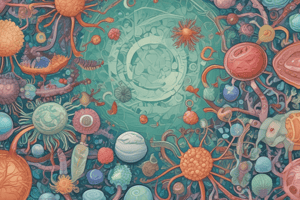Podcast
Questions and Answers
What is the most diverse group of organisms?
What is the most diverse group of organisms?
- Bacteria
- Archaea
- Eukarya
- Prokaryotes (correct)
How do all prokaryotic cells reproduce?
How do all prokaryotic cells reproduce?
- Sexually
- By fragmenting
- By budding
- Asexually (correct)
What is the primary method of division for prokaryotic cells?
What is the primary method of division for prokaryotic cells?
- Binary fission (correct)
- Budding
- Fragmentation
- Snapping division
What is the basis for modern prokaryotic classification?
What is the basis for modern prokaryotic classification?
What is a characteristic of Archaea?
What is a characteristic of Archaea?
What type of organisms require extreme conditions of temperature, pH, and/or salinity to survive?
What type of organisms require extreme conditions of temperature, pH, and/or salinity to survive?
What is the function of methanogens?
What is the function of methanogens?
What is a characteristic of Lactobacillus?
What is a characteristic of Lactobacillus?
What is a characteristic of Staphylococcus?
What is a characteristic of Staphylococcus?
What type of bacteria lack cell walls?
What type of bacteria lack cell walls?
Flashcards are hidden until you start studying
Study Notes
Prokaryotes
- Most diverse group of organisms
- Can be found in various habitats, including:
- Antarctic glaciers to thermal hot springs
- Colons of animals to cytoplasm of other prokaryotes
- Distilled water to supersaturated brine
- Disinfectant solutions to basalt rocks
- Only a few capable of colonizing humans and causing disease
Morphology of Prokaryotic Cells
- Various shapes, including:
- Coccus
- Coccobacillus
- Bacillus
- Vibrio
- Spirillium
- Spirochete
- Pleomorphic
Reproduction of Prokaryotic Cells
- All reproduce asexually
- Three methods:
- Binary fission (most common)
- Snapping division
- Budding
Arrangements of Prokaryotic Cells
- Result from two aspects of division during binary fission
- Planes in which cells divide:
- Cocci divide in multiple places, bacilli in only one
- Separation of daughter cells
Modern Prokaryotic Classification
- Based on genetic relatedness of rRNA sequences
- Three domains:
- Archaea
- Bacteria
- Eukarya
Survey of Archaea
- Common features:
- Lack peptidoglycan
- Cell membrane lipids have branched hydrocarbon chains
- Lack tRNA specific for thymine
- AUG codon codes for methionine
- Reproduce by:
- Binary fission
- Budding
- Fragmentation
- Most are:
- Cocci
- Bacilli
- Spiral forms
- Unusual shapes exist
- Not known to cause disease in humans or animals
Extremophiles
- Require extreme conditions of:
- Temperature
- pH
- Salinity
- To survive
- Prominent members:
- Thermophiles
- Halophiles
Thermophiles
- DNA, RNA, cytoplasmic membranes, and proteins do not function properly below 45°C
- Hyperthermophiles require temperatures over 80°C
Halophiles
- Inhabit extremely saline habitats
- Depend on greater than 9% NaCl to maintain integrity of cell walls
- Contain red or orange pigments for protection from:
- Visible light
- UV light
- Most studied: Halobacterium salinarium
Methanogens
- Convert carbon dioxide, hydrogen gas, and organic acids to methane gas
- Largest group of archaea
- Convert organic wastes in:
- Pond sediments
- Lake sediments
- Ocean sediments
- To methane
- Some live in colons of animals, contributing to environmental methane
- Have produced ~10 trillion tons of methane buried in mud on ocean floor
Low G+C Gram-Positive Bacteria
Clostridia
- Rod-shaped, obligate anaerobes
- Important in medicine and industry
- Produce toxins that cause diseases in humans
- Endospores survive harsh conditions
- Related microbes:
- Epulopiscium
- Sulfate-reducing microbes
- Selenomonas
Mycoplasma
- Facultative or obligate anaerobes
- Lack cell walls
- Smallest free-living cells
Bacillus
- Endospore-forming aerobes and facultative anaerobes
- Many common in soil
- Bacillus thuringiensis toxin is used as an insecticide
- Bacillus anthracis causes anthrax
- Other species synthesize antibiotics
Listeria
- Contaminates milk and meat products
- Can reproduce under refrigeration
- Survives inside phagocytic white blood cells
- Rarely causes disease in adults
- Can kill the fetus if crosses the placenta in pregnant women
Lactobacillus
- Grows in the human mouth, stomach, intestinal tract, and vagina
- Rarely causes disease
- Inhibits the growth of pathogens within the body
- Used in the production of various foods
Streptococcus and Enterococcus
- Cause numerous diseases
- Various strains of multi-drug-resistant streptococci
Staphylococcus
- One of the most common inhabitants of humans
- Produces toxins and enzymes that contribute to disease
High G + C Gram-Positive Bacteria
Corynebacterium
- Pleomorphic aerobes and facultative anaerobes
- C.diptheriae causes diptheria
Mycobacterium
- Aerobic rods that sometimes form filaments
- Slow growth, partly due to mycolic acid in cell walls
- Some species are pathogens of animals and humans
Actinomycetes
- Form branching filaments resembling fungi
- Cause disease primarily in immunocompromised patients
- Important genera
Studying That Suits You
Use AI to generate personalized quizzes and flashcards to suit your learning preferences.




